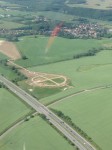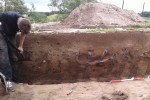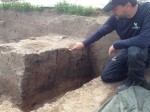 Archaeologists excavating the 10th century Viking Borgring fortress discovered on the island of Zealand, Denmark, in 2014, are calling the cops to help solve a 1,000-year-old mystery. The fortress was first identified with drone footage, laser scanning and a geomagnetic survey. Test pits were then dug at key positions which confirmed that this was Trelleborg-type fortress, one of a series of defensive ring forts built around 980 A.D. by King of Norway and Denmark Harald Bluetooth.
Archaeologists excavating the 10th century Viking Borgring fortress discovered on the island of Zealand, Denmark, in 2014, are calling the cops to help solve a 1,000-year-old mystery. The fortress was first identified with drone footage, laser scanning and a geomagnetic survey. Test pits were then dug at key positions which confirmed that this was Trelleborg-type fortress, one of a series of defensive ring forts built around 980 A.D. by King of Norway and Denmark Harald Bluetooth.
 One of the original test pits was dug where the north gate would have been. Archaeologists found large oak timbers, evidence of the massive gates typical of Trelleborg forts, that were charred from fire. Funds for a full excavation of the site were secured last year. Excavations began in earnest this year. Thus far the team has unearthed more evidence of fire at the east gate. The outer posts of the gate are charred through, and posts from inside the gate bear marks of burning.
One of the original test pits was dug where the north gate would have been. Archaeologists found large oak timbers, evidence of the massive gates typical of Trelleborg forts, that were charred from fire. Funds for a full excavation of the site were secured last year. Excavations began in earnest this year. Thus far the team has unearthed more evidence of fire at the east gate. The outer posts of the gate are charred through, and posts from inside the gate bear marks of burning.
 The working theory right now is that the fort was attacked by Danish noblemen before it was completed during an uprising against Harald Bluetooth’s rule. Harald’s son Sweyn Forkbeard rebelled against his father in the mid-980s. According to Saxo Grammaticus, chronicler and author of the Gesta Danorum, Sweyn’s forces defeated Harald and forced him to flee to Jomsborg where he died of his wounds.
The working theory right now is that the fort was attacked by Danish noblemen before it was completed during an uprising against Harald Bluetooth’s rule. Harald’s son Sweyn Forkbeard rebelled against his father in the mid-980s. According to Saxo Grammaticus, chronicler and author of the Gesta Danorum, Sweyn’s forces defeated Harald and forced him to flee to Jomsborg where he died of his wounds.
Archaeologists also found that the fort was not complete, that construction appeared to have ended halfway through. That suggests it was the last fort Harald built, that it was started at the end of his reign, became a target of rebel forces and was left unfinished after his defeat and death.
In the hopes of getting more information about the fire, archaeologists have reached out to police fire safety investigators. They want forensic arson specialists to study the burned areas of the structure.
“Hopefully, they can say more about how the fire was started. We generally have good experience of cooperation with the police. For instance, we have previously used their sniffing dogs to dig out bones from the earth,” Sanne Jakobsen, communications manager at Southeast Museum Denmark told Danish Radio.
 The team will also do dendrochronological analysis of the timbers to narrow down the date of the fort. Excavations will continue for three months every summer through 2018, after which the plan is to close up archaeological shop and let the field return to nature. The clock is ticking, therefore. If you have a chance to see the site in the next couple of years, take it. Visitors can download an app to learn more about the other Trelleborg forts, Borgring and the archaeological finds made at the site.
The team will also do dendrochronological analysis of the timbers to narrow down the date of the fort. Excavations will continue for three months every summer through 2018, after which the plan is to close up archaeological shop and let the field return to nature. The clock is ticking, therefore. If you have a chance to see the site in the next couple of years, take it. Visitors can download an app to learn more about the other Trelleborg forts, Borgring and the archaeological finds made at the site.
Here’s a video of the site which is open to the public right now. There are mounds and trenches from the active excavation at the east gate.
[youtube=https://youtu.be/s9wuReeUdmE&w=430]
You can keep up with the excavation on the Vikingeborgen Borgring Facebook page.
Åttåck with å burning thing
Can måke å børg å fiery ring
Venial tendency to cønspire
Turned it intø å ring of fire
chorus:
We turned it intø å burning ring øf fire
The børg went døwn, døwn, døwn as the flåmes climbed higher
Ånd it burned, burned, burned the ring øf fire
The ring øf fire
———
Cøuntry ‘n Western Såga (trad.),
dedicated to Sjælland fire station